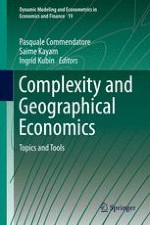2015 | OriginalPaper | Chapter
Diffusion of Growth and Cycles in Continuous Time and Space
Author : Tönu Puu
Published in: Complexity and Geographical Economics
Publisher: Springer International Publishing
Activate our intelligent search to find suitable subject content or patents.
Select sections of text to find matching patents with Artificial Intelligence. powered by
Select sections of text to find additional relevant content using AI-assisted search. powered by
